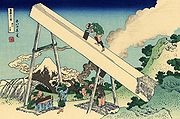National Gallery for Foreign Art
42°41′46″N 23°20′4″E / 42.69611°N 23.33444°E
Национална галерия за чуждестранно изкуство | |
 National Gallery for Foreign Art building | |
 | |
| Established | 1985 |
|---|---|
| Location | Sofia, Bulgaria |
| Collection size | 10,000 items |
| Director | Slava Ivanova [1] |
| Website | http://www.nationalartgallerybg.org |
The National Gallery for Foreign Art (Bulgarian: Национална галерия за чуждестранно изкуство, Natsionalna galeriya za chuzhdestranno izkustvo) of Bulgaria is a gallery located on St. Alexander Nevsky Square in Sofia. It serves as the country's national institution for non-Bulgarian art. It is situated in the 19th-century Neoclassic edifice of the former Royal Printing Office.
History
The edifice of the NGFA was built between 1882 and 1884 during the rule of
A large portion of the donations were made through the "13 Centuries of Bulgarian Statehood" fund, established by Lyudmila Zhivkova in the 1980s.
Since May 2015, collections of the National Gallery for Foreign Art are exhibited together with the 19th and 20th century collections of the
Collections
The gallery's permanent exposition features
Indian Art
Halls One, Two and Three hold exhibitions of Indian art. Hall One is centered on Indian miniature. The collection includes works with traditional motives, paintings from the Mughal era and the Delhi Sultanate and the art schools of Rajasthan and Pahara. Hall Two contains religious sculptures from 320 to 550 AD. The figures represent Hindu gods like Vishnu, Ganesha, Brahma, Shiva and Krishna. Hall Three holds an exhibition of very rare 16th century sculptures of Christian saints from Goa, influenced by Indian tradition.
Japanese art
Hall Four holds a collection of various Japanese ukiyo-e prints, dating from the 18th century. It is the main artistic genre of woodblock printing in Japan. Usually the word ukiyo is literally translated as "floating world" in English, referring to a conception of an evanescent world, impermanent, fleeting beauty and a realm of entertainments (kabuki, courtesans, geisha) divorced from the responsibilities of the mundane, everyday world; "pictures of the floating world", i.e. ukiyo-e, are considered a genre unto themselves. The collection offers an insight into the development of ukiyo-e from monochrome to polychrome prints, as well as the first contacts of Japanese and European art. Some of the artists included are Hokusai, Hiroshige, Kikukawa Eizan and Utamaro.
African art
The
Buddhist art from Southeast Asia
Hall Six exhibits Buddhist art from the region of Southeast Asia, primarily from the Pagan Kingdom and other areas of what is today Myanmar. Sculptures of the Buddha in the different positions and from various materials, as well as manuscripts and other fine and applied arts, date as early as the 11th century AD. This collection was donated to the Gallery in 1987.
European fine arts
This article needs additional citations for verification. (January 2017) |
Halls Seven, Eight and Nine display a rich collection of European fine arts from the 15th to the 20th century. Hall Seven is concentrated mostly around
Other
Halls 11 to 19 hold various expositions, including a Salon d'Automne (Hall 18), a collection of Parisian-themed and authored works of the early 20th century, modern Spanish art, a display dedicated to Nicholas Roerich, as well as the Nova Hall where temporary exhibitions are held.
Accessibility
The NGFA is situated in the very centre of Sofia, at St. Alexander Nevsky Square, behind the building of the National Assembly and the
| Service | Station/Stop | Lines/Routes served | Distance from NGFA |
|---|---|---|---|
| Vasil Levski Monument | 11 | 100 m | |
| Sofia University | 1 | 350 m |
Gallery
-
Statue of the Buddha from the Pagan Kingdom
-
In the Mountains of Totomi by Hokusai
-
Madonna and Child by Antonio da Correggio
References
- ^ a b "Bulgarian National Gallery for Foreign Art website" (in Bulgarian and English). Archived from the original on 2008-05-15. Retrieved 2008-09-28.
- ^ "The municipal buildings from the Liberation until 1920" (in Bulgarian). Sofia Municipality website. Archived from the original on 2006-05-24. Retrieved 2006-07-24.
- ^ "За нас" (in Bulgarian). Национална галерия за чуждестранно изкуство. Archived from the original on 2008-05-15. Retrieved 2009-07-25.
- ^ The Sofia Globe staff (27 May 2015). "Bulgaria's 'Square 500' national gallery opens on May 28". The Sofia Globe. Retrieved 16 August 2016.
- ^ Information, NGFA



